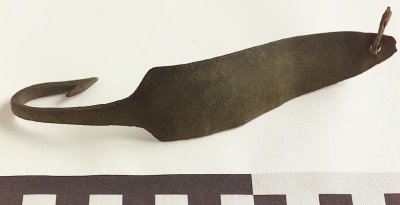Fornvännen's Autumn Issue

The autumn issue of Fornvännen arrived a week or two ago, and I've somehow forgotten to write about it. As usual, it's full of exciting stuff.
Patrik Gustafsson and Mikael Nordin of the Södermanland County Museum in Nyköping report on survey work in Kolmården, a mountainous forest that formed an uninhabited boundary zone between the tribal territories of the Svear and Götar back in the 1st Millennium AD. Patrik and Mikael have located a number of Early Mesolithic shore-bound sites up there, dating from the 7th and 8th Millennia cal BC. Shore displacement in these parts has been dramatic.
Helmer Gustavson, John Hamilton and Laila Kitzler Åhfeldt of Stockholm report on the fragments of at least three Migration Period pictorial stelae found in later graves at Tomteboda on the outskirts of Stockholm. One of the stones has had a runic inscription, which is very rare at that early date, but unfortunately too few runes survive for them to be read. As part of the upheavals in the mid-6th century, people were clearly vandalising stone monuments erected only decades before.
David Damell and Martin Edlund in Örebro report on excavations at Råsvalslund in northern Västmanland. Far from any other known Viking Period settlements, they have found a large and affluent village with innovative construction techniques and well-equipped graves. David and Martin argue that the village's prosperity must have been founded upon iron production, which is well attested for the Viking Period in the area. They also found something really unusual: a bronze fishing lure!
There are a number of shorter items as well in this issue, but I'll just point out Henrik Thrane's opinion piece, which I really like. In the 1990s a funny tubular pottery object was found at a Bronze Age settlement near Norrköping. The excavators interpreted it as a damaged female figurine, something I couldn't really see at the time as they didn't offer even vaguely similar comparative material. But what do I know about the Bronze Age? Anyway, Thrane has now demolished their interpretation. As it turns out, the tubular thing is an ornate bellows nozzle used for bronze casting. It belongs to a common artefact class known from most of Continental Europe and discussed in the literature for over a century. It's just that this is the first time that it's identified among Swedish finds. And it took a senior Danish colleague to get it straight.
I think the poorly founded figurine idea was a typical result of overspecialisation: Swedish contract archaeologists are absolutely ace at fieldwork, but they rarely have any opportunity to learn about small finds. Nor are there any formalised channels for them to communicate with Sweden's few professional finds specialists. But I'm always glad to look at finds photographs. Keep 'em coming to my mailbox, folks!
[More blog entries about archaeology, Sweden; arkeologi.]
Labels: archaeology, Sweden



2 Comments:
Vad säger den skeptiske arkeologen om Lindström brödernas bok?
http://www.svd.se/dynamiskt/rec_litteratur/did_13942991.asp
Douglas
All I know about the book is what's in the review. But I agree with the reviewer, "Thou Shalt Not Speculate".
My opinion regarding the 1st Millennium AD is that the petty kings of the Svear and those of the Götar where most likely entirely comparable. Neither tribe did much to attract international notice before the 17th century. Peripheral farmers.
Post a Comment
<< Home